Rather than continuing to post about our trip to Italy which ended about five weeks ago, I'm putting that on the back burner and will be posting about the next trip which began in just a matter of days after returning from Italy to French Polynesia.

Steven and I had only been back from our 2.5-month-long trip to Europe for just 9 days before jetting off again for a 3-week jaunt to French Polynesia. Normally, we wouldn't have considered such a crazy timeline but last spring we noticed an OMG price of just $250 per person for a one-way flight from Tahiti to San Francisco and decided to jump on it as we had nothing else planned then. Even though we just had time to celebrate American Thanksgiving with some of our children and switch out clothes for the French Polynesia adventure, we were excited to fly off into the wild blue yonder again!
A long flight from San Francisco brought us to Pape'ete in Tahiti, the largest of the 118 Society Islands in French Polynesia and the eastern gateway to the South Pacific. Beginning in 1842, Pape'ete was used as the headquarters for French governors who 'protected' the island. Now the city is the cultural, communications, economic, as well as political center of French Polynesia.
Our small but very well-equipped room for our only night in Tahiti before escaping to a nearby island:
The rooster was my companion when I had some tea on the patio well before Steven got up the next morning! I loved wandering around the property and admiring the tropical flowers.
Steven and I only had until mid-afternoon to explore Pape'ete before flying to Huahine, the first of four islands we'd tour in the next three weeks. After driving into town the night before after our 8-hour flight from San Francisco, we were immediately struck by the number of colorful murals and street art.
Just a few minutes walk from the property was the large pink Temple de Paofai was an evangelical church that was also called Siloama. It was built on the site of the first Protestant church in 1818. Too bad that not only was it closed but we weren't there on a Sunday morning to hear the sermon in Tahitian and Polynesian singing and see women in interesting hats.
A nearby park with the temple in the background:
The Jardins de Paofai or Paofai Gardens was the main walking area along the waterfront.
Even though a busy street was adjacent to the gardens, the paths meandered past lots of palm trees and the area was still a pleasant place to stroll.
Pape'ete means "water basket" most likely because islanders originally used calabashes enclosed in baskets to fetch water at a spring behind the current Territorial Assembly. After being founded as a mission station by Reverend William Crook in 1818, whalers frequented the port in the 1820s because it provided better shelter than Matavi Bay. When Queen Pomare settled in Pape'ete in 1827, it became the seat of government.
We spotted lots of outrigger canoes or pirougues in the harbor but unfortunately, no teams were out racing that day.
Though it all appeared so peaceful and serene, French naval facilities were constructed in the harbor area in the 1960s to enable nuclear testing.
On Pape'ete's western edge was Place To'ata, a square that was home to a large pavilion for rock concerts and traditional festivities.
The waterfront memorial celebrated Tahiti's independence in 1984.
The memorial site remembered the 193 atomic bombs that France detonated for nuclear testing. The land and people of five archipelagos faced significant upheaval as nuclear tests were imposed on them. The memorial was inaugurated in 2006 on the 40th anniversary of the first nuclear test on Moruroa Atoll.
A block from the waterfront was the large central market that was completely rebuilt in 1987 on the site of an older market building. On the main floor were Tahitians selling local handicrafts as well as local fruits and vegetables.
Suellen: Notice the large CU banner? What a scream seeing it on the upper floor especially since there it was the only university represented!
The view over the main floor gave us a great sense of how really large the market was as it had looked deceptively small from the outside.
Plans for the Catholic Notre Dame Cathedral began in 1856 with stone that was to be imported from Australia and a granite doorway from the Gambier Archipelago. However, money ran out shortly after construction began so the original building was scrapped in 1867 and this smaller one was completed in 1875.
We couldn't help but notice the Polynesian faces and the mix of Tahitian and Western attire on the stained-glass windows.
The PKO marker in front of the cathedral was like Milepost 0 with all distances on the island marked from there.
More murals caught my eye.
When the three-story Hotel de Ville or City Hall was built in 1990, it was designed to resemble the former Queen Pomare IV Palace located nearby.
After a 63-day voyage from France, Paul Gaugin landed in Pape'ete. His life on the island was told in a fictional tale by Somerset Maugham called The Moon and Sixpence.
A fairly long walk on a busy street from the center of town was the brightly colored Chinese Temple, also known as Kanti de Mamao.
No interior photos of the temple could be taken so I took this from the entrance before being shooed away.
I liked how the street signs in Pape'ete also listed some island history.
I expected grocery prices in French Polynesia would be crazy but never in my wildest dreams did it occur to me a pint of raspberries or a quart of strawberries would cost $10 each!
We were glad that Place Valete had a gazebo as it was a perfect place to seek refuge during a downpour. Little did we realize then how many short deluges we'd experience over the next three weeks!
I was excited when we happened on a nearby square that was the location for a small handicrafts market. The prices and choices were much better than at the larger central market we'd visited earlier.
In front of the Territorial Assembly was a monument erected in 1982 to Pouvanaa a Oopa, a Tahitian WW I hero who strove his entire life to achieve independence for his country.
Nearly a third of Tahiti's adult population gathered here in 1995 to protest French nuclear testing in the region.
We were fortunate that we were free to wander around the picturesque Assembly grounds, located on the site of the former royal palace that was demolished in 1966. The only negative was that the assembly wasn't meeting so we could have observed their proceedings. At the back of the compound was a peaceful botanical garden away from the bustle of the capital.
The lily pond separated the gardens from those of the adjacent French High Commissioner's residence. Below the huge banyan tree used to be the royal bathing pond.
More street art that caught our attention:
Believe me, several hours were enough for us to see Pape'ete's limited sights before our flight to the nearby island of Huahine.
Huahine Airport:
Next post: The small town of Fare on Huahine.
Posted on December 29th, 2021, from our home in the Denver suburb of Littleton. This has been a tough year for everyone and, for far too many, one of extreme suffering and sadness. Steven and I hope that the new year will bring you and your loved ones peace, good health, and a chance to travel where you want.

























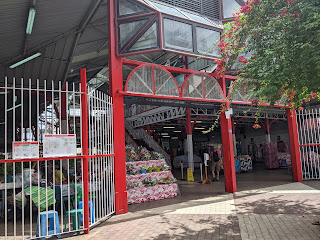








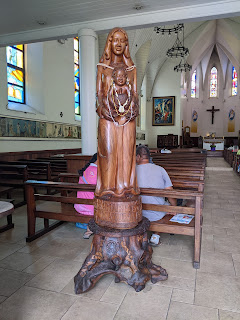


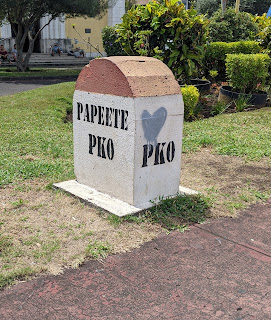




























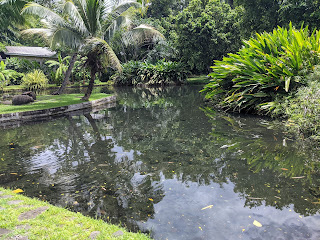


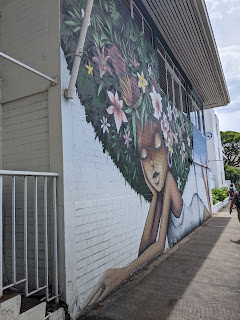






No comments:
Post a Comment